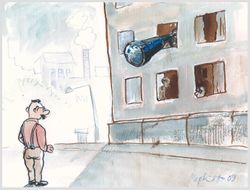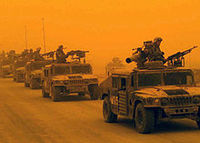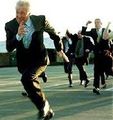Neighborhood Watch
“Little men dressed in brief authority.”
– Shakespeare, 17th century plus some other stuff
A neighborhood watch is an excellently organized group of outstanding citizens who do all they can to prevent crime in their immediate neighbourhood. The most important function of a neighbourhood watch is to keep an eye on any suspicious persons - loiterers, suspect youth gangs, and suchlike. If the situation demands, a watch can also turn into a virtual police force to help stop a crime wave in its tracks.
People who choose to join the "watch" do so for various virtuous purposes. Even more importantly, the standard issue yellow window stickers also afford excellent viewing cover when keeping an eye on exactly what it is that Mrs Jones is bringing back on the roof of her car.
History
Early history
The end of the 19th century was a restless period in U.S. history. There were sorry incidents like the New York Draft Riots of 1863, Tulsa Race Riot of 1876, and the Chicago Race Riot (1857-1885), to mention just a few. The era definitely called for affirmative action on the part of watchful citizens, ready to sacrifice everything for the safety of the nation and, most importantly, their immediate surroundings.
Thus, on 18. April 1879, Mrs. Cunningham of Memphis, Tennessee came up with the idea of organizing her neighbors into an effective task force which would survey and police the quarter of Hogshead in which she lived. Her reasoning was that since Mr. Cookson had recently moved in from as far away as California and didn't look her in the eyes when they met, there had to be something wrong with the neighborhood. Mrs. Cunningham paid a visit to Mrs. Jones and told her about Mr. Cookson's bad manners; those had to hint at a twisted personality and some horrible secret like fancying your friend's spouse - which could some day be Mrs. Cunningham herself! That evening, history was made. Mrs. Jones immediately saw the problem and let all her friends in the spinster club know that bad element had just moved into the neighborhood. Before long the idea of neighborhood watches was spreading like wildfire all across America, soon reaching even Europe in the form of letters and telegrams. It is worthwhile to mention that Mr. Cookson was later on trial for conspiracy to steal a pound of flour from the local grocery store.
1920s - 40s
The decades between the two world wars saw interesting changes in neighbourhood watches around the world. Neighbourhood watches in India were more concentrated on protecting the population from the British Imperialists (except when elephants go must, in which case they would organise a neighbourhood watch get George Orwell to shoot it), as opposed to enforcing strict caste laws.
The Hindenburg crash of 1937 scared neighbourhood watches into keeping a close eye out for possible crashing zeppelins over New Jersey streets.
Women's suffrage was granted in 1920 in the United States. For some time during and after the women's rights movement (women's rights hahaha), male-organized neighbourhood watches throughout the 20s often included men watching for possible incidences of women going out to vote. The same was not uncommon in the UK as women were not fully granted equal suffrage in the UK until about 1928.
During the prohibition era in the United States, neighbourhood watches were used to tip off moonshining activities and speakeasies to the authorities, but to no avail. As neighbourhood watches are usually biased towards the law rather than any actual moral code, it was not surprising that as soon as prohibition ended the neighbourhood watches on such activities also ended.
The popular Scopes trial focused neighbourhood watch attention in looking out for humanzees and evolutionists who were then easily identifiable (according to propaganda) by their horns and tridents made of test tubes and use of absurd terms like "scientific theory" and "fossil record".
The Great Depression saw a spike in crime rates and a decline in neighborhood watches as nobody had time to volunteer when they would much rather be unemployed migrant workers in breadlines. Understandably this all changed as the war came along. Young men went off to fight dirty Germans and Japs, and neighborhood watches focused on looking for espionage and locking up Asian-looking people in camps for security's sake. Ironically, these Japanese internment camps developed their own neighborhood watches in which they attempted to curve violence understandably caused by stressful conditions in the camps. They also served to harangue Chinese camp members who were mistakenly placed in the camps. References to raping Nanking were common.
1950s
In the United States, the Red Scare became an area of focus for neighbourhood watches in suburbs across the country. Americans sincerely believed that at any moment the pinkos were going to rush into their streets, steal their mail, and eat their children. Neighbourhood watches distributed informational pamphlets from the FBI titled Your Neighbor Could Be A Commie. The pamphlet often gave cheesy acronyms for identifying possible Communists, such as "P.A.L.M." (People with Alarmingly Large Moustaches; if the mustache is longer than your palm, then they're probably a Commie). They were also accurately informed that Communists smell of vodka and wear red after May Day, and warned to be on the look-out for anyone attempting to install Soviet missile silos, for which there must always be a permit.
As a result of these time-consuming anti-Communist efforts - since the Communists were very devious and the watches badly undermanned - neighborhood watches in the United States became largely ineffective at preventing crime. In other words, crime rates spiked since investigators, helped by enthusiastic volunteers, were too busy trying to find reds. The joint efforts of the police and the watches at beating up suspect black people were, however, a heroic success. Republicans have since defended these historical efforts, arguing that while finding Commies might have been a waste of the taxpayers dollars (for which they say Democrats are to blame), beating up black people was two decades worth of fun and games.
The most notable event of the era happened in January of 1955, when Mr. Wellington of Pitsburg, Louisiana noticed Mr. Laurie's disturbing habit of standing half-naked in his bedroom almost every time Mr. Wellington peeked through the window. The watch consequently sent Mr. Laurie a formal letter informing him he would have to drop his disgusting habits or move out.
1960s/70s
The Civil Rights Movement saw a major split in neighborhood watch ideology. Watches in the Southern United States were very interested in segregation practices and made sure that blacks didn't drink from the same water fountain, lest they have watermelons thrown at them. This vigilante attitude sometimes got violent, which led to the formation of neighborhood watches especially created for not only snitching but enforcement and cohersion. One neighborhood watch group known at the KKK emerged among them all as well-organized and having very sexy costumes that needed much bleaching.
Hippies were also targeted in neighborhood watches. Neighborhood watches were taught by the authorities to identify hippies by odor, dress, and vernacular. It was even insinuated that hippies could be among their neighborhoods discreetly planning horrible things like tree hugging and guitar playing. Gasp!
A great worry was made in neighborhood alertness and neighborhood watch education, particularly around the alarm of blood-curdling screams as though somebody in the neighborhood was being violently stabbed to death with a knife which was, prior to the Kitty Genovese murder, not known to be an indication that somebody in the neighborhood might be being violently stabbed to death with a knife.
1980s/90s
80s pop culture was notoriously cheesy in every aspect. This cheesiness spilled over into the serious business of stopping crime with the introduction of anti-crime ads with "McGruff the Crime Dog", a talking canine dressed in a grey trenchcoat with the collars up so as to appear watchful and hide his mouth foam. The ads were created in the United States by the National Crime Prevention Council for use by American police in building crime awareness among children. The reasoning behind his introduction was that it was assumed that most children are fond of dogs that walk upright.
Present-day
The current system of neighborhood watches began developing in the late 1960s as a response to really boring day time television. The most important milestone in the history of modern Neighbourhood Watch is 27.8.2006. Then, in Baggesborough, Great Britain, people became outraged after a very buxom young lady had moved into number 96 and a dozen witnesses did nothing to inform others. Many were left watching re-runs of MacGyver when they could have been looking out of the window. Locals all over Lancashire found new enthusiasm to form groups to watch over their neighborhoods and to look out for any potentially entertaining activity in the future. These groups mostly consisted of full-time pensioners who could thus fulfill a meaningful position in today's complicated society.
The truth about watchers
No matter what the hell anyone else said, watchers are just that. Watchers. All they ever do is watch. Maybe it's a video. Maybe it's a bird being slaughtered by a gathering of evil Nazi cats with the scent of Jew bird blood, or maybe their watching your grandchildren playing in the backyard when grandpa comes out with a shotgun yelling, "Get off my lawn you fucking scallywags!". They end up having their brains being fried from over exhaustion and their eyes melting because the blood of the bird that got slaughtered is actually acidic because it's an alien out of the movie "Alien" in disguise. They end up dying from all this after a very short lifespan, making them a very primitive and easy to destroy species. An easy way to identify a near-to-death watcher is by looking at their eyes. If they are completely black, they aren't actually demons which many non-sceptics and religious flakes believe in, but they are actually about to die. An easy way to kill one is to watch THEIR grandchildren playing in the backyard and then running out dressed up like an old paedophile with a shotgun and yelling, "Get off my lawn you fucking scalawags!" This shall cause them to have what we call a heart attack, but since they do not have hearts their hermaphrodite organs commit suicide somehow causing them to die. That is the exact truth of a watcher, nothing more, nothing less.[1]
Types of watcher
Watchers may be divided into the following:
- Curtain twitchier: Easily identified by sudden and unexpected movements of the curtains.
- Single man with an unusually large telescope: No seriously, I'm sure he's got a perfectly reasonable reason to have that telescope. He's probably into astronomy or something.
- Dog walker Possibly the best excuse used by the watcher when he needs to cover ground in order to find out about things which are not directly visible from their house.
- Whistlers: Be extremely suspicious of anyone whistling. A Whistler may simply be a dog walker without his dog, but typically whistling is a sure sign of particularly devious activities as reviled
Allegations of an actual contribution to crime fighting
It has been suggested that some neighbourhood watch systems do actually help prevent crime... Although it is generally agreed that most join the...
Organizations
- Hitler Youth
- Red Guard
- Grenadier Guards
- KGB
- Black Panthers
See also
- HowTo:Defend your Home from Drug-crazed Mexicans
- HowTo:Prevent your car radio from being stolen
- HowTo:Keep the French out of your Country
- HowTo:Run Away From Fat Ladies
- HowTo:Misbehave in a Library
- Why?:Is My House Mad At Me
- Why?:HIDE!
Images
- ↑ Asha, in case you don't believe me, I did actually write this.













